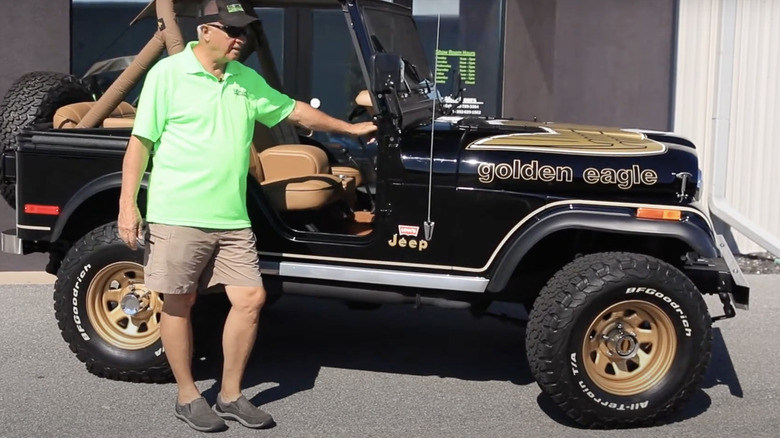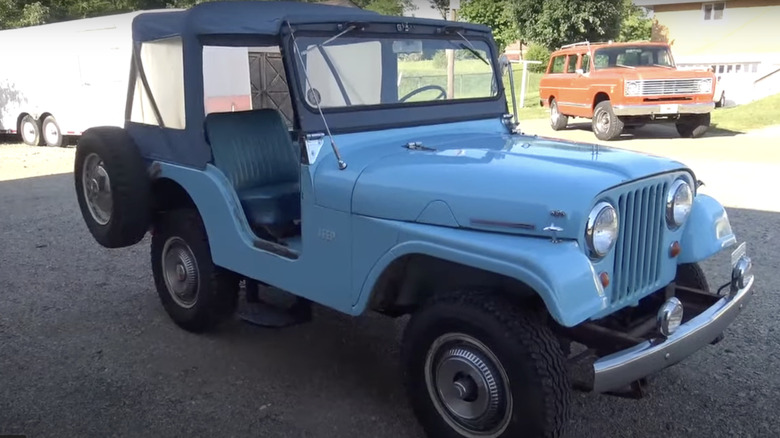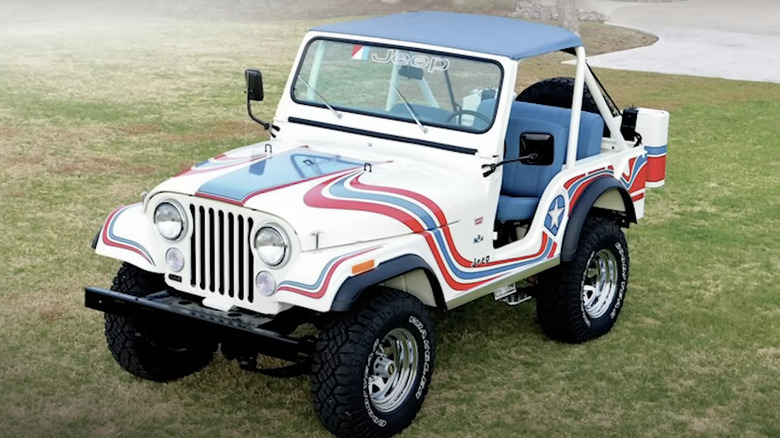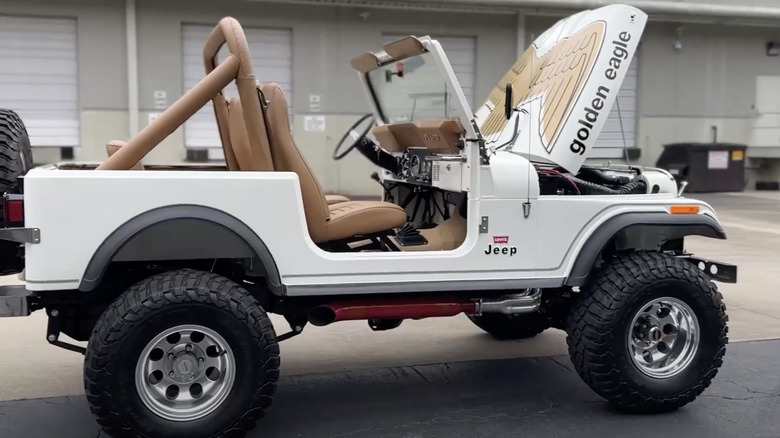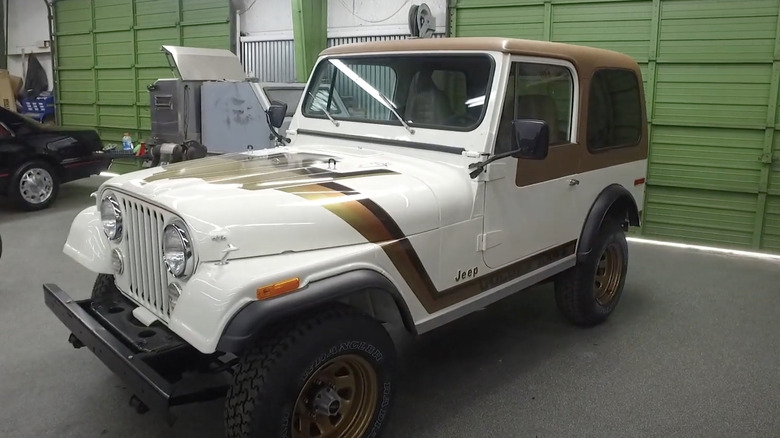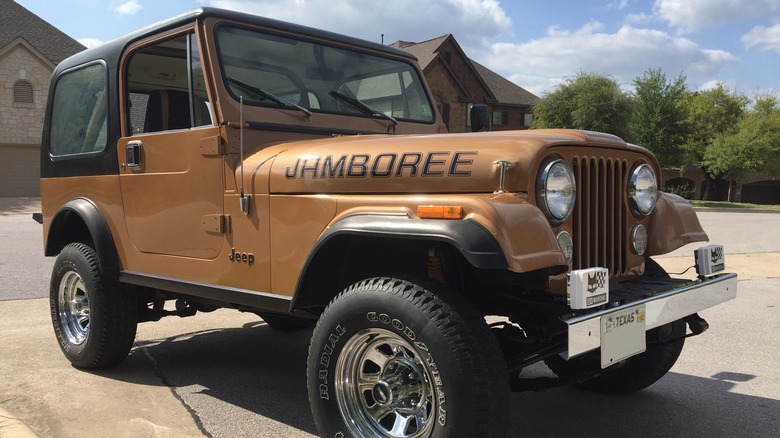5 Special Edition Jeep CJs (And What They're Worth Today)
The Jeep brand got started when WIllys Overland built a light-utility vehicle for the U.S. Army and its allies during World War II. Those MA and MB model Jeeps evolved into the CJ (Civilian Jeep) line, which began with the 1945 CJ-2A. That model ran through 1949 before going through a long chain of updates that lasted nearly four decades. The CJ line finally ended when Chrysler bought the Jeep brand along with the rest of American Motors' holdings in 1987.
At that point, Chrysler morphed the very similar CJ5 and CJ-7 into the Wrangler, which is now in its fourth generation. Throughout its lifetime, the CJ was known more for substance than style, but from time to time the various custodians of the Jeep brand saw fit to create some special versions of this short, squat, open-air off-road machine. Most of them were cosmetic packages, but some included functional adaptations of the vehicle that eventually saw a total production run of more than 1.5 million units. The majority of those were standard-issue CJ5s and CJ7s, which is exactly why the special editions often fetch a hefty premium.
CJ5 Tuxedo Park
One of the earliest special edition Jeep CJ models is the Tuxedo Park, which began as an option package in 1961 but became a standalone model in 1964. The Tuxedo Park treatment was available on the CJ5 and CJ6 and included chrome front bumpers, dashboard grab bars, and hubcaps. In advertising for the Tuxedo Park, Jeep called the model "Stylish as a sports car, tough as a truck." Comfort-oriented features included softer rear leaf springs and extra padding for the vinyl seats. Tuxedo Park CJs aren't terribly common, with fewer than 2,000 CJ5A models made in 1965 and total production for the CJ6A version not quite reaching 500 units.
As expected, that makes the Tuxedo Park CJ more valuable than a run-of-the-mill CJ from that era. Hagerty values the 1964 – 1966 CJ5A Tuxedo Park at $16,500 in good condition, although we found two that sold in the past two years for under $10,000.
Super Jeep
An even rarer special edition CJ was the CJ5 Super Jeep, which saw a limited production run of just a few hundred units in 1973. The Super Jeep was developed when a shortage of aluminum alloy wheels prompted Jeep to tweak its Renegade package, swapping the alloy wheels for steel ones and designing a new graphics package. It was offered in six colors, with Jetset Blue and Champagne White Super Jeeps getting intricate red and blue stripes that swooped from the hood to the rear quarters. For the other four body colors, the stripes were orange and white.
The special package included a 258 cubic-inch straight-six engine with an upgraded cooling system, a fixed tailgate, and rear seats with seatbelts. In 1975, AMC made plans to re-issue the red, white, and blue Super Jeep for the following year's bicentennial, but the existence of the celebratory Super Jeep remained unverified legend until Dennis Collins of Discovery's "Gas Monkey Garage" discovered the one pictured above near his Texas shop in 2012. It's difficult to value a model that exists in such sparse numbers, but Motor Trend cites "$25,000 or more" as the going price for a Super Jeep in prime condition. We were only able to find two current listings: one in Kent, Washington for an even $20,000, and another in Grand Rapids, Michigan, for about twice that. In 2019, one Super Jeep owner initially asked a cool million for his, but soon dropped his price to a more appropriate — but still steep — price of $45,500.
Golden Eagle
The Golden Eagle package was available on the CJ5 from 1977 through 1983 on the CJ5 and 1980 on the CJ7. For $200 extra on top of the cost of the base Renegade, buyers got a large eagle decal on the hood and submodel badging on the hood's outer edges. Under that hood sat a 304 cubic inch V8 that produced as much as 150 horsepower and 245 pound-feet of torque. The TV series "The Dukes of Hazzard," which ran from 1979 through 1985, featured a 1980 CJ7 Golden Eagle as the chosen ride of Daisy Duke (Catherine Bach).
Although factory production of the Golden Eagle represents just a portion of CJs over those years, aftermarket decal packages make it possible to pass a standard CJ off as a Golden Eagle if it has a 304 under the hood. This is a smart way to invest a few hundred bucks, as Golden Eagles are worth a bit more than standard CJs. Hagerty lists the value of a 1979 CJ5 Golden Eagle at just under $20,000, while the same Jeep without the special designation sits at about $5,000 less. The real-world value appears to be even higher, though. We found three current listings for CJ5 Golden Eagles, all close to or above the $30,000 mark. CJ7 Golden Eagles are valued at between $36,300 and $55,700 by Hagerty depending on condition.
Golden Hawk
Like the Super Jeep, the Golden Hawk was a one-year model only. The package was offered in 1980 and also on the Cherokee, which sported the same abstract bird logo on the hood and body-length stripes as the CJ versions. Unlike some of Jeep's other CJ special edition packages, the Golden Hawk offered few mechanical or comfort-related improvements over the standard CJs beyond some high-backed seats and fog lamps. Production numbers have been hard to pin down, but Motoexotica Classic Cars in St. Louis, Missouri cites a figure of about 650 units for the CJ7 version.
As with the Golden Eagle, aftermarket decal packages are available to turn an ordinary CJ into a Golden Hawk. This makes them hard to value accurately, since it can be difficult to identify genuine Golden Hawk CJs accurately. Hagerty puts fair value for a CJ7 Golden Hawk in good condition at $22,200. That is surprisingly more than a thousand dollars under the average sale price for a 1980 CJ7 over the past five years, according to classic.com.
Jamboree
Yet another one-year-only special edition CJ has roots going back to 1952. That was when a handful of Jeep owners in Georgetown, California brainstormed a way to bring tourists back to the town that had once been a Gold Rush hub. The next year, the first Jeepers Jamboree was held, drawing 55 Jeeps with 155 people aboard (via Motor Trend). They made an off-road excursion on an old stagecoach road to Lake Tahoe that is now known as the Rubicon Trail, and the Jamboree became an annual event.
Jeep celebrated the 50th Anniversary of the first Jamboree by introducing the Wrangler Rubicon, which had all sorts of trail-ready add-ons like locking differentials, 31-inch tires, and the ability to cross 20 inches of water. In 1982, AMC had already marked the Jamboree's 30th year by producing the CJ7 Jamboree edition, which added a 20-gallon fuel tank, 28.9-inch tires, and an upgraded electrical system. The CJ7 Jamboree was pricey with an unadorned cost of about $9,900, but adding the optional off-road package with winch, lighting, fire extinguisher, and CB radio brought the cost to $12,903. That equals almost $43,000 today, which is almost twice the $22,100 value that Hagerty places on a 1982 Jamboree. Mecum Auctions claims a production run of just 630 units, and sold one for $21,000 this past January.
[Featured image by Ebickel via Wikimedia Commons|Cropped and scaled|CC-By 4.0]
